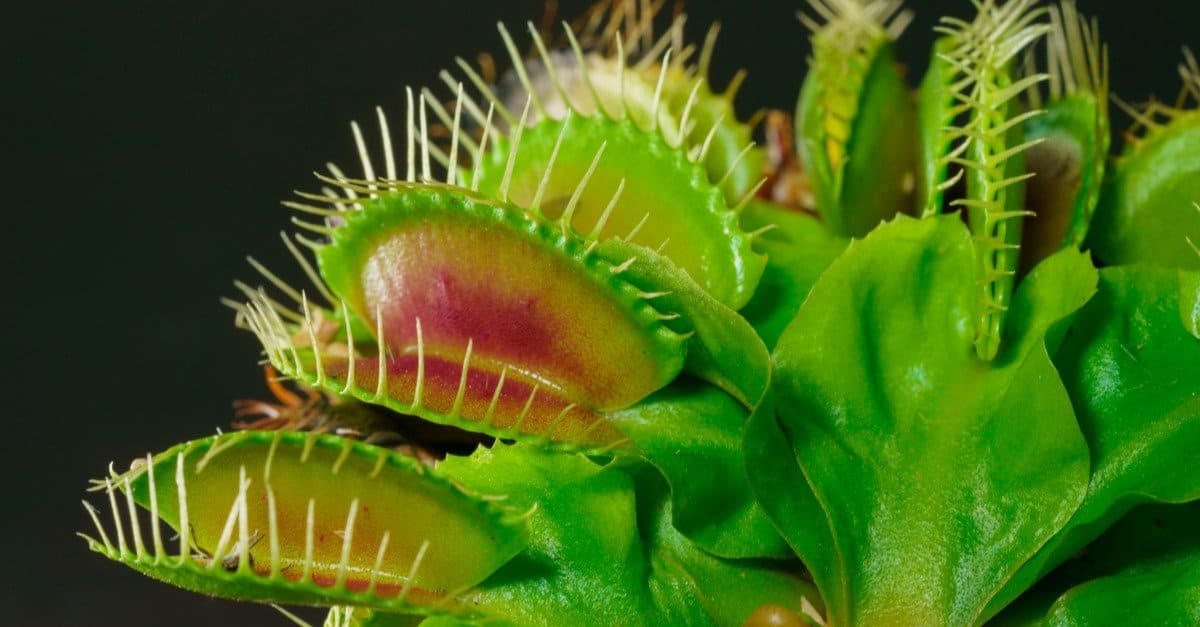Gnats can be pesky little critters that buzz around us, making outdoor and even indoor activities less enjoyable. But fear not! Nature has its secret weapon against these tiny terrors: plants. Certain plants have the superpower to repel gnats and keep them at bay. In this article, we’re diving into the green world of gnat-repelling plants, discovering how they work their magic.
In addition to our list of fantastic plants that repel gnats, we’re also going to look at some additional alternative ways that you can get rid of gnats both indoors and outdoors. We promise it’s not a lost cause. There are a ton of ways to get rid of gnats, and many of them are very effective! But first, let’s check out some plants that could very well get the job done for you.

1. Lemon Thyme

Lemon thyme is known for its strong, citrus-like scent.
©Nahhana/Shutterstock.com
Lemon thyme, a fragrant herb with small green leaves and a citrusy aroma has been found to effectively repel gnats. These tiny flying insects, often a nuisance in outdoor spaces, can be deterred by the natural compounds present in lemon thyme. The strong scent emitted by the plant contains oils that gnats find unpleasant, causing them to seek alternative areas for habitation.
To utilize lemon thyme as a gnat repellent, you can plant it in your garden or keep potted plants near doorways, windows, or outdoor seating areas. Crushed or bruised leaves release more of the repellent oils, intensifying the effect. Additionally, placing bundles of dried lemon thyme indoors can discourage gnats from entering your home.
Scientifically known as Thymus citriodorus, lemon thyme offers a natural and environmentally friendly solution to gnat problems. Unlike chemical repellents, it doesn’t harm beneficial insects or pose risks to humans or pets. By harnessing the power of lemon thyme, you can create a more pleasant outdoor environment free from the annoyance of gnats.
2. Chrysanthemum
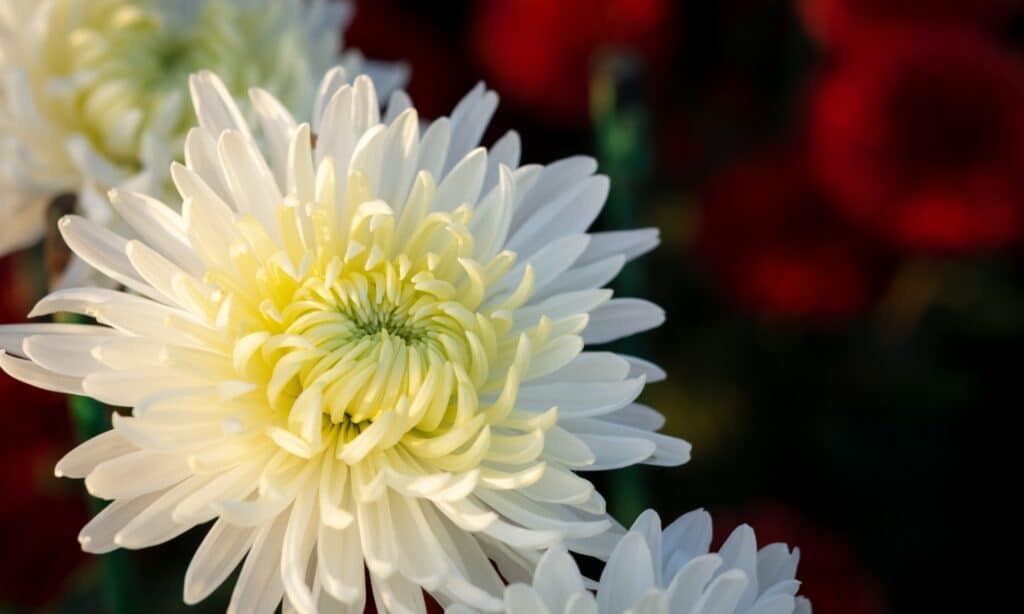
Chrysanthemums are stunning flowers in addition to doing a great job at repelling gnats.
©iStock.com/Anna Pismenskova
Chrysanthemums are vibrant and colorful flowers often seen in gardens. They can also serve as effective natural repellents against gnats. These small, flying insects are known for their annoying presence, especially during warmer months. Chrysanthemums contain natural compounds called pyrethrins, which have been found to deter and repel gnats due to their potent scent and insect-repelling properties.
The strong aroma emitted by chrysanthemums is what helps keep gnats at bay. Pyrethrins interfere with the nervous systems of gnats and other insects, making them less likely to linger in areas with these flowers. Planting chrysanthemums in your garden or placing potted varieties near entrances and outdoor seating areas can help create a gnat-free zone.
It’s worth noting that while chrysanthemums can be a useful natural repellent, they can also be toxic to certain insects, so care should be taken when using them around beneficial pollinators like bees. Additionally, some individuals may be sensitive to the scent of chrysanthemums, so consider this aspect when placing them in your outdoor space.
Incorporating chrysanthemums into your landscaping not only adds beauty but also contributes to a more comfortable outdoor experience by keeping pesky gnats at a distance without resorting to chemical repellents.
3. Venus Flytrap
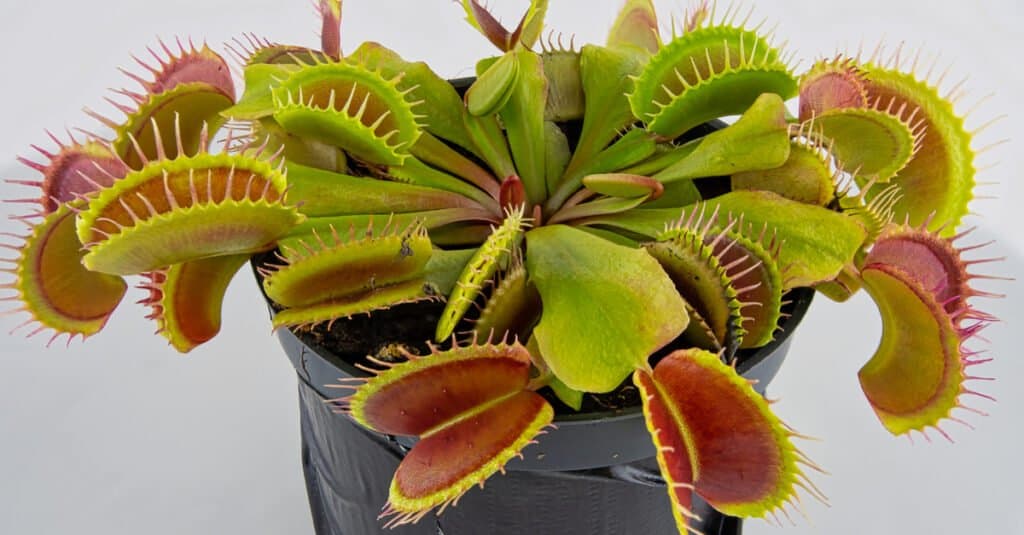
Venus Flytraps are native to North and South Carolina.
©Craig Russell/Shutterstock.com
Venus flytraps are unique carnivorous plants native to certain parts of the United States. If you know anything about these unique plants, you probably won’t be surprised to learn that they repel (or, rather, eat) gnats. These tiny flying insects are drawn to the sugary nectar produced by plants, but the Venus flytrap takes a different approach. Instead of luring them in, it traps and consumes them.
The Venus flytrap’s leaves, divided into two lobes with tiny “trigger hairs,” snap shut quickly when touched by an insect. While the plant primarily feeds on insects for nutrients, it also serves as a natural repellent. Gnats that come into contact with the sensitive trigger hairs trigger the plant’s response, causing the leaves to close and capture the gnat.
Though venus flytraps might not emit scents like other repellent plants, their active trapping mechanism targets gnats directly. For outdoor spaces with gnat problems, placing venus flytraps strategically can help reduce their population. However, it’s important to note that these plants require specific care and environments to thrive.
Growing Venus flytraps not only offers a natural way to manage gnat issues but also introduces a fascinating and unique botanical element to your space.
4. Lemongrass
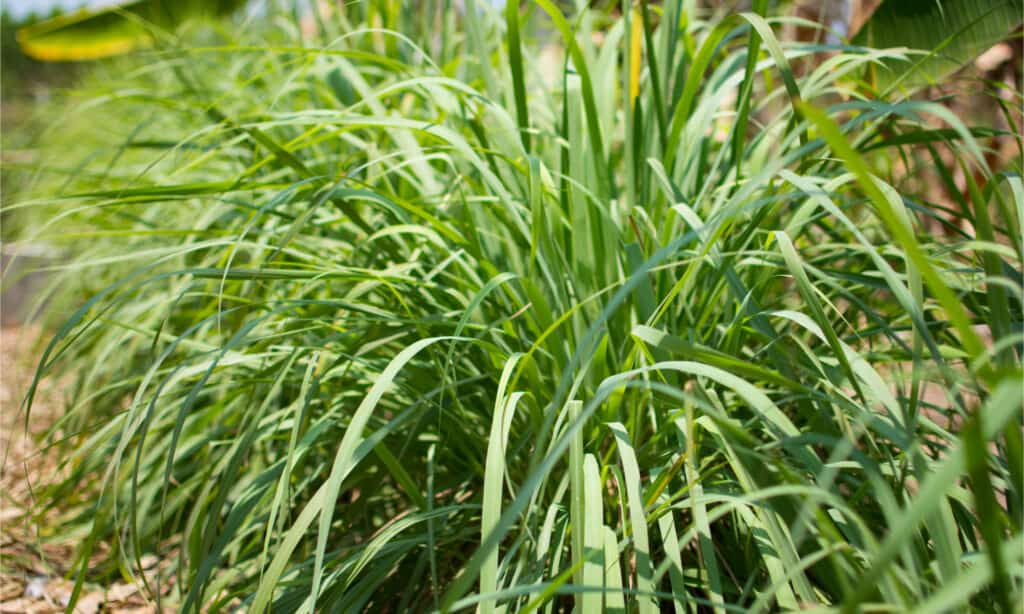
Lemongrass is a healthy herb that is popular in many different cuisines.
©Nannie_iiuu/Shutterstock.com
Lemongrass is a fragrant herb often used in cooking and herbal teas that also possesses the remarkable ability to repel gnats. These small flying insects can be a nuisance, especially in outdoor areas in high-humidity places. Lemongrass contains a natural oil called citronella, which is known for its strong and pleasant lemony scent. This scent acts as a natural repellent against gnats and other flying pests.
Citronella oil, found in the leaves of lemongrass, disrupts the gnats’ ability to locate their preferred breeding and feeding areas. Planting lemongrass in your garden or keeping potted plants near entrances and outdoor seating can help create a gnat-free zone. Crushing the leaves slightly releases more of the citronella scent, enhancing its effectiveness.
Unlike chemical-based repellents, lemongrass offers an environmentally friendly solution that doesn’t harm beneficial insects or pose risks to humans and pets. Its dual benefits of culinary use and pest control make it a valuable addition to any outdoor space. By harnessing the power of lemongrass, you can enjoy your outdoor activities without the annoyance of gnats.
5. Garlic
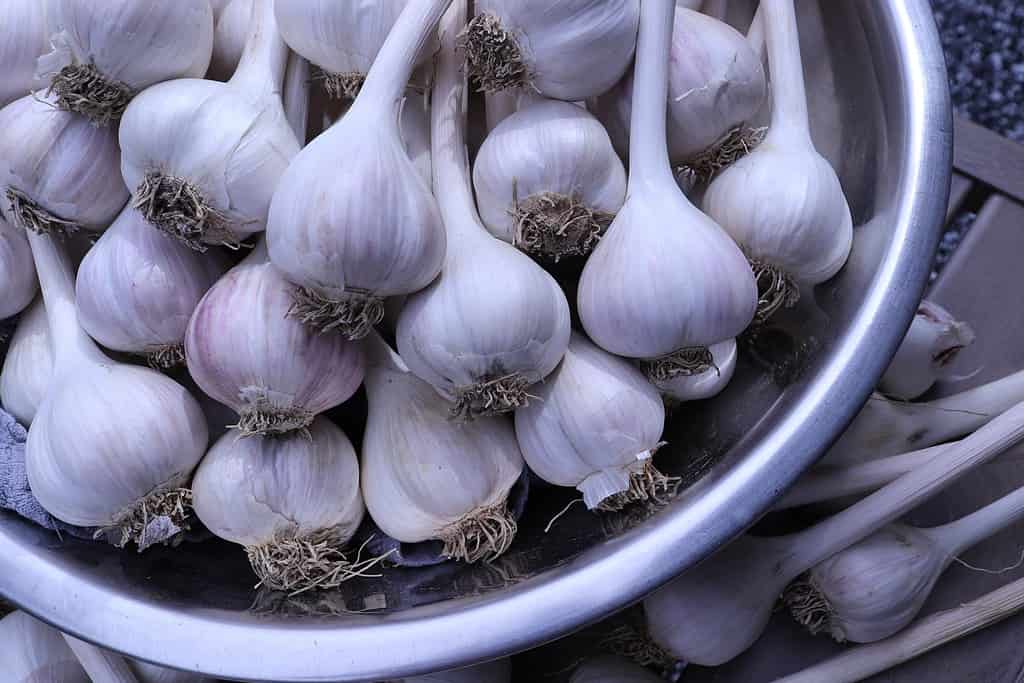
Garlic is worth growing for its culinary uses alone, but they are excellent gnat repellers as well.
©KC Melete/Shutterstock.com
Garlic is quite well-known for its culinary uses and strong aroma, and it can also serve as an effective natural repellent against gnats. The pungent scent of garlic contains compounds that gnats find unappealing, making it an ideal repellent.
When garlic is crushed or minced, it releases sulfur-containing compounds such as allicin, which gives garlic its distinctive smell. This scent acts as a deterrent for gnats, keeping them away from the area. Planting garlic in your garden or placing garlic cloves in outdoor containers can help repel gnats effectively.
An added benefit of using garlic as a gnat repellent is its natural and non-toxic nature. Unlike chemical-based solutions, garlic doesn’t harm beneficial insects or pose risks to humans or pets. This makes it an environmentally friendly option for gnat control. By incorporating garlic into your outdoor environment, you can enjoy the space without the annoyance of gnats buzzing around.
6. Cape Sundew
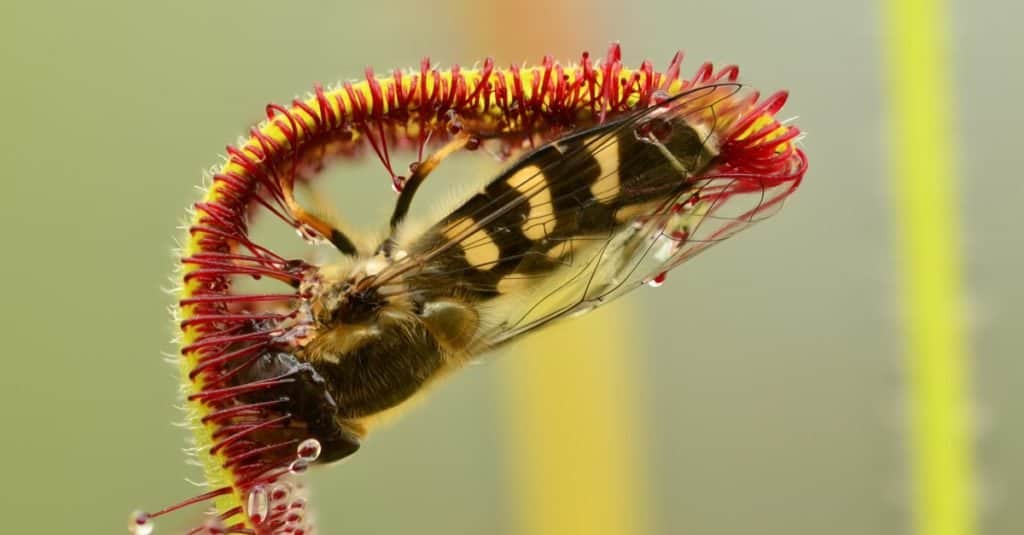
Sundew plants (pictured) in general are great for taking care of pests.
©Robert Evenflow/Shutterstock.com
Cape sundew is an intriguing carnivorous plant native to South Africa that also has a remarkable ability to repel gnats. As we’ve established, gnats are drawn to the sugary secretions of plants. However, the cape sundew takes a different approach. Its leaves are covered in tiny, hair-like structures that glisten with a sticky substance.
When gnats come into contact with these sticky hairs, they become trapped. The cape sundew then releases enzymes that digest the insects, providing the plant with nutrients. While the primary purpose of these sticky traps is to capture food, they also serve as a natural repellent. The cape sundew’s unique adaptation targets gnats directly, reducing their presence in its vicinity.
Cultivating cape sundew in your garden or pots can help manage gnat populations in outdoor spaces. This natural approach doesn’t involve harmful chemicals and is safe for beneficial insects, pets, and humans. It’s worth noting that cape sundews require specific growing conditions, including high humidity and ample sunlight.
Adding cape sundew into your outdoor or indoor environment not only offers an effective way to control gnats but also introduces a captivating and unusual plant to your surroundings. By embracing the cape sundew’s insect-trapping strategy, you can enjoy a gnat-free space while appreciating the wonders of nature’s adaptations.
7. Basil
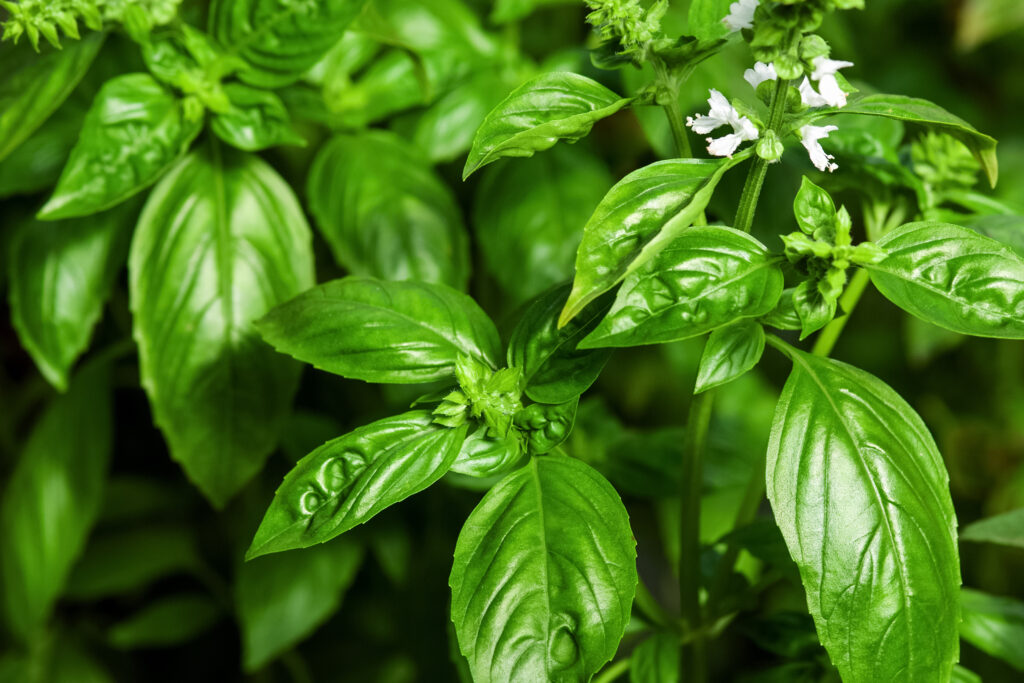
Basil has a delightful fragrance that gnats thankfully hate. Try growing yours outdoors or on your windowsill in your kitchen if you have sink gnats.
©Nadya So/Shutterstock.com
Basil is an aromatic herb commonly used in cooking. It also emits a strong and pleasant scent due to its essential oils, which serve as a natural repellent against gnats.
The essential oils found in basil, such as eugenol and citronellol, are responsible for its distinctive aroma. These oils create a fragrance that gnats find displeasing, causing them to stay away from areas where basil is present. Planting basil in your garden or placing potted basil near doorways, windows, or outdoor seating can help create a gnat-free environment.
To maximize basil’s repellent effect, you can gently crush its leaves to release more of the essential oils. This intensifies the scent and enhances its effectiveness in deterring gnats. Unlike chemical-based repellents, basil offers a safe and eco-friendly solution that doesn’t harm beneficial insects or pose risks to humans and pets.
Beyond its repellent properties, basil is a versatile herb that adds flavor to various dishes and can be easily grown in different climates. By incorporating basil into your outdoor space, you not only enhance your culinary experiences but also ensure a more enjoyable outdoor atmosphere free from the annoyance of gnats.
8. Butterwort
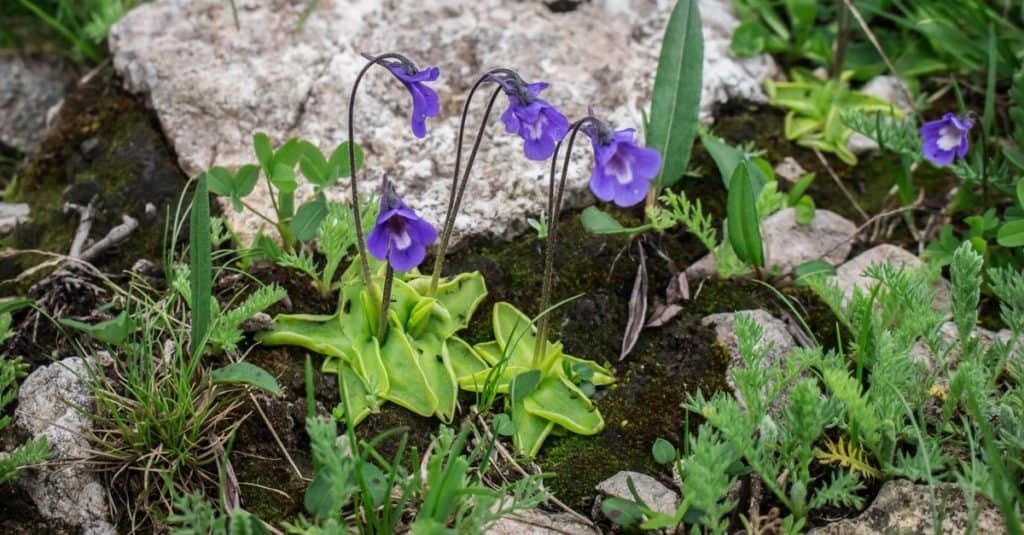
Butterwort plants are visually pleasing in addition to being major gnat-eaters.
©IvanaStevanoski/Shutterstock.com
Butterwort is an intriguing carnivorous plant found in various parts of the world. Gnats are naturally drawn to areas with moisture and organic matter. Butterworts, however, have evolved a different strategy to counteract them.
Butterwort leaves are covered in glandular hairs that exude a sticky substance. When gnats land on these leaves, they become trapped in the adhesive liquid. The plant then secretes enzymes that break down the insects, enabling the butterwort to absorb nutrients. While the primary purpose of this mechanism is to capture food, it also serves as a natural repellent. The presence of sticky leaves deters gnats from landing and feeding on the plant.
Growing butterworts in your outdoor space or cultivating them in pots can help manage gnat populations. This natural approach doesn’t involve harmful chemicals and is safe for beneficial insects, pets, and humans. Butterworts typically thrive in areas with ample sunlight and well-draining soil.
9. Marigold

If your flower garden is dealing with gnats, marigolds are a great way to deal with the problem.
©EQRoy/Shutterstock.com
Marigolds are bright and cheerful flowers often found in gardens that possess a remarkable ability to repel gnats. They emit a scent that gnats find unappealing, making them a natural and effective repellent.
The scent produced by marigolds comes from compounds called pyrethrins, which are commonly used in insect-repellent products. These compounds have insecticidal properties that interfere with the nervous systems of gnats and other insects. By planting marigolds in your garden or placing potted marigold plants near entrances and outdoor seating areas, you can create a gnat-free zone.
Marigolds come in various species and colors, offering options to suit different preferences and garden designs. The vivid colors and pleasant scent of marigolds also make them a decorative addition to outdoor spaces. Additionally, marigolds are known for their ability to deter other pests, such as aphids and mosquitoes.
Utilizing marigolds as a gnat repellent is an environmentally friendly approach that avoids the use of harsh chemicals. This natural method helps maintain a balanced ecosystem in your garden by not harming beneficial insects.
Other Ways to Repel Gnats
1. Citrus Scents
Gnats dislike strong citrus odors. You can create a simple repellent by mixing citrus essential oils like lemon, orange, or grapefruit with water in a spray bottle. Spray this solution around outdoor seating areas to deter gnats.
2. Vinegar Traps
A mixture of apple cider vinegar and a few drops of dish soap can act as a trap for gnats. The vinegar’s scent attracts them, while the dish soap breaks the surface tension of the liquid, causing the gnats to sink and drown.
3. Vanilla Extract
The sweet aroma of vanilla extract can repel gnats. Mix a tablespoon of vanilla extract with water and apply it to your skin before heading outdoors.
4. Essential Oil Repellents
Besides citrus oils, gnats also dislike oils like eucalyptus, lavender, and peppermint. Mix a few drops of these oils with a carrier oil (like coconut or jojoba oil) and apply it to any exposed skin.
5. Dryer Sheets
Believe it or not, dryer sheets can keep gnats away. Tuck a dryer sheet into your pocket or tie one onto a belt loop when spending time outdoors.
6. Camphor Solution
Create a solution by dissolving camphor tablets in water and placing them in a bowl near outdoor gathering spots. The scent of camphor acts as a gnat repellent.
7. Fan Power
Gnats are weak fliers and can be kept away by creating a breeze with fans. Set up fans around your outdoor area to create an inhospitable environment for gnats.
8. Baking Soda and Sugar
Mixing equal parts of baking soda and sugar can help deter gnats. Place small containers of this mixture around your outdoor space to discourage them.
9. Clean Surroundings
Gnats are attracted to moisture and decaying organic matter. Regularly clean up standing water, food spills, and garbage to eliminate breeding sites.
10. Avoid Fragrances
Strong perfumes, lotions, and scented body products can attract gnats. Opt for unscented products when spending time outdoors.
Summary of Plants That Effectively Repel Pesky Gnats
| # | Plant | Type |
|---|---|---|
| 1 | Lemon Thyme | Herb |
| 2 | Chrysanthemum | Flower |
| 3 | Venus Flytrap | Carnivorous Plant |
| 4 | Lemongrass | Herb |
| 5 | Garlic | Vegetable |
| 6 | Cape Sundew | Carnivorous Plant |
| 7 | Basil | Herb |
| 8 | Butterwort | Carnivorous Plant |
| 9 | Marigold | Flower |
Thank you for reading! Have some feedback for us? Contact the AZ Animals editorial team.

